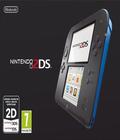Just days prior to PAX Prime 2013, Nintendo made some really big moves with its lineup, including a price drop on the Wii U and an unexpected early release date for The Legend of Zelda: Wind Waker HD. Though this news was positive to the dedicated Nintendo fan base and other gaming observers, one item left everyone scratching their heads: the announcement of the Nintendo 2DS, a console that's more of a side-grade to the existing 3DS family instead of a new line. We checked it out at PAX Prime 2013 and came away fairly surprised.
For clarification, the Nintendo 2DS still has the existing functionality of the 3DS and larger 3DS XL. It can take original Nintendo DS software cards, digital DSi games from the eShop, and 3DS games in card and digital format. It still accepts normal SD cards for storage and has three cameras (two in the back, facing away from the player, one in the front facing the player), so it can take pictures in 3-D. All of the buttons are there, and the system still sports one analog disc instead of two. The bottom screen is still a touch-screen that lacks multi-touch capabilities, and Wi-Fi allows for online play, local play, and StreetPass functionality. This is, for all intents and purposes, a Nintendo 3DS with some big changes.
The first big change is the design. Gone is the traditional folding clamshell design Nintendo has depended on since the original Nintendo DS. Instead, it's opted for a wedge design with a thinner lower end; it looks more like a tablet since the folding capabilities are gone. The analog disc and main interface buttons are in the middle of the slab on the left and right sides, and the shoulder buttons are a little wider. Start and Select have moved to the lower right side and are rounded, much like they were with the DS Lite. The Home button remains in the same place, but it's also rounded while there is a Sleep switch in place of the Wi-Fi switch. As for the stylus, it's still housed at the side of the portable and plastic, but it sits somewhere between the original DS stylus and the Wii U/3DS XL stylus in terms of size while retaining the thickness of the 3DS XL stylus.
Despite how the press shots appear, the device is not that big. It is roughly the same size as the original 3DS opened, and it has the same screen sizes, too. You wouldn't try to fit it in your pocket due to the lack of protection on the screens, but it isn't as large and bulky as portables of yesteryear. What is more surprising is that it's very comfortable to hold. The wedge shape seems perfectly suited for the hand, and despite the top half being comprised of more plastic, the whole unit felt balanced. Button placement worked well, and the larger triggers felt like they had more spring than on the other 3DS systems — but without losing any responsiveness. There's not much to complain about in this area.
The other big change is the lack of 3D. Even though you can still take 3-D photos and have them display in 3-D on other 3DS consoles, the 2DS displays the top screen with no stereoscopic 3-D. The effect is no different from what current 3DS and 3DS XL owners experience when they turn off the 3-D on the systems, so the experience isn't dramatically different. It also means that users won't have to worry about holding the system at just the right angle.
The initial gut reaction to this latter change is, "Why?" After all, the 3DS was really marketed as a device that was capable of glasses-free 3-D, and taking away that aspect leaves you with a great portable system, but without a big gimmick. Some of this could've been predicted when Nintendo started to talk less about the 3DS's 3-D feature. Fewer people use it due to the performance hit and how it drained the battery life, but we suspect the main reason for the removal of the 3-D feature was kids. Both the system and the games come with warnings about exposure to 3-D imagery for little kids, and while the system still sells well, many parents won't touch it due to the potential damage it could do to their child's eyesight. Eliminating that feature returns those parents to Nintendo's fold.
The Nintendo 2DS is scheduled to hit the market Oct. 12, the same day as Pokemon X & Pokemon Y. Given that game release date, the system changes make perfect sense, and its $129.99 price tag means the handheld will do well.
More articles about Nintendo 2DS











 Nintendo 2DS is designed specifically for anyone looking for a more affordable entry point into the world of Nintendo hand-held video games and plays all 3DS and DS games in 2D.
Nintendo 2DS is designed specifically for anyone looking for a more affordable entry point into the world of Nintendo hand-held video games and plays all 3DS and DS games in 2D.


